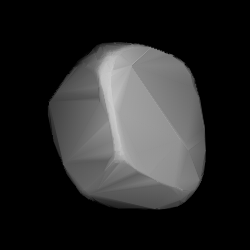Astronomy:1391 Carelia
 Modelled shape of Carelia from its lightcurve | |
| Discovery[1] | |
|---|---|
| Discovered by | Y. Väisälä |
| Discovery site | Turku Obs. |
| Discovery date | 16 February 1936 |
| Designations | |
| (1391) Carelia | |
| Pronunciation | /kəˈriːliə/[6] |
| Named after | Karelia (European region)[2] |
| 1936 DA · 1949 MR | |
| Minor planet category | |
| Orbital characteristics[3] | |
| Epoch 31 May 2020 (JD 2459000.5) | |
| Uncertainty parameter 0 | |
| Observation arc | 83.97 yr (30,670 d) |
| |{{{apsis}}}|helion}} | 2.9677 AU |
| |{{{apsis}}}|helion}} | 2.1278 AU |
| 2.5478 AU | |
| Eccentricity | 0.1648 |
| Orbital period | 4.07 yr (1,485 d) |
| Mean anomaly | 228.13° |
| Mean motion | 0° 14m 32.64s / day |
| Inclination | 7.5962° |
| Longitude of ascending node | 103.33° |
| 85.875° | |
| Physical characteristics | |
| Mean diameter | 11.079±0.111 km[7] |
| Rotation period | 5.87822±0.00001 h[8] |
| Pole ecliptic latitude | |
| Geometric albedo | 0.214±0.021[7] |
| Absolute magnitude (H) | 11.8[1][3] |
1391 Carelia (prov. designation: 1936 DA) is a stony background asteroid from the central region of the asteroid belt. It was discovered on 16 February 1936, by Finnish astronomer Yrjö Väisälä at Turku Observatory in Southwest Finland.[1] The S-type asteroid has a rotation period of 5.9 hours and measures approximately 11 kilometers (6.8 miles) in diameter. It was named for the Northeast European region of Karelia.[2]
Orbit and classification
Carelia is a non-family asteroid of the main belt's background population when applying the hierarchical clustering method to its proper orbital elements.[4][5] It orbits the Sun in the central main-belt at a distance of 2.1–3.0 AU once every 4 years and 1 month (1,485 days; semi-major axis of 2.55 AU). Its orbit has an eccentricity of 0.16 and an inclination of 8° with respect to the ecliptic.[3] It was first observed at Heidelberg Observatory, extending the body's observation arc by 2 days prior to its official discovery observation at Turku.[1]
Naming
This minor planet was named after the northeastern European region of Karelia, located between the Gulf of Finland and the Russian White Sea. The naming was mentioned in The Names of the Minor Planets by Paul Herget in 1955 (H 126).[2] Since the Winter War between the Soviet Union and Finland in 1939–40, most of the regions belongs now to Russia. A large part of Yrjö Väisälä's discoveries have names that are in some form or another related to that war about Karelia.
Physical characteristics
In the Tholen taxonomy, Carelia is a stony S-type asteroid, the most common type in the inner main-belt.[3] The asteroid is also an S-type in the SDSS-based taxonomy.[9]
Rotation and pole
In 2016, a rotational lightcurve of Carelia was published using modeled photometric data from the Lowell Photometric Database (LPD). Lightcurve analysis gave a rotation period of 5.87822±0.00001 hours ({{{1}}}), as well as two spin axes at (21.0°, −79.0°) and (208.0°, −43.0°) in ecliptic coordinates (λ, β).[8]
Diameter and albedo
According to the survey carried out by NASA's Wide-field Infrared Survey Explorer with its subsequent NEOWISE mission, Carelia measures 11.079 and 11.570 kilometers in diameter and its surface has an albedo of 0.1972 and 0.214, respectively.[7][5] The Collaborative Asteroid Lightcurve Link assumes a standard albedo for stony asteroids of 0.20 and calculates a diameter of 11.46 kilometers based on an absolute magnitude of 12.07.[10]
References
- ↑ 1.0 1.1 1.2 1.3 1.4 "1391 Carelia (1936 DA)". Minor Planet Center. https://www.minorplanetcenter.net/db_search/show_object?object_id=1391. Retrieved 3 April 2017.
- ↑ 2.0 2.1 2.2 Schmadel, Lutz D. (2007). "(1391) Carelia". Dictionary of Minor Planet Names. Springer Berlin Heidelberg. p. 112. doi:10.1007/978-3-540-29925-7_1392. ISBN 978-3-540-00238-3.
- ↑ 3.0 3.1 3.2 3.3 3.4 3.5 3.6 3.7 "JPL Small-Body Database Browser: 1391 Carelia (1936 DA)". Jet Propulsion Laboratory. https://ssd.jpl.nasa.gov/sbdb.cgi?sstr=2001391. Retrieved 16 March 2020.
- ↑ 4.0 4.1 "Asteroid 1391 Carelia – Proper Elements". AstDyS-2, Asteroids – Dynamic Site. https://newton.spacedys.com/astdys/index.php?pc=1.1.6&n=1391.
- ↑ 5.0 5.1 5.2 5.3 5.4 "Asteroid 1391 Carelia". Small Bodies Data Ferret. https://sbntools.psi.edu/ferret/SimpleSearch/results.action?targetName=1391+Carelia. Retrieved 16 March 2020.
- ↑ Karelian, Carelian (3rd ed.), Oxford University Press, September 2005, http://oed.com/search?searchType=dictionary&q=Karelian%2C+Carelian (Subscription or UK public library membership required.)
- ↑ 7.0 7.1 7.2 Masiero, Joseph R.; Grav, T.; Mainzer, A. K.; Nugent, C. R.; Bauer, J. M.; Stevenson, R. et al. (August 2014). "Main-belt Asteroids with WISE/NEOWISE: Near-infrared Albedos". The Astrophysical Journal 791 (2): 11. doi:10.1088/0004-637X/791/2/121. Bibcode: 2014ApJ...791..121M. http://adsabs.harvard.edu/cgi-bin/bib_query?bibcode=2014ApJ...791..121M. Retrieved 3 April 2017.
- ↑ 8.0 8.1 Durech, J.; Hanus, J.; Oszkiewicz, D.; Vanco, R. (March 2016). "Asteroid models from the Lowell photometric database". Astronomy and Astrophysics 587: 6. doi:10.1051/0004-6361/201527573. Bibcode: 2016A&A...587A..48D. http://adsabs.harvard.edu/cgi-bin/bib_query?bibcode=2016A&A...587A..48D. Retrieved 3 April 2017.
- ↑ 9.0 9.1 Carvano, J. M.; Hasselmann, P. H.; Lazzaro, D.; Mothé-Diniz, T. (February 2010). "SDSS-based taxonomic classification and orbital distribution of main belt asteroids". Astronomy and Astrophysics 510: 12. doi:10.1051/0004-6361/200913322. Bibcode: 2010A&A...510A..43C. https://sbnarchive.psi.edu/pds3/non_mission/EAR_A_I0035_5_SDSSTAX_V1_1/data/sdsstax_ast_table.tab. Retrieved 16 March 2020. (PDS data set)
- ↑ "LCDB Data for (1391) Carelia". Asteroid Lightcurve Database (LCDB). http://www.minorplanet.info/PHP/generateOneAsteroidInfo.php?AstInfo=1391. Retrieved 3 April 2017.
External links
- Lightcurve Database Query (LCDB), at www.minorplanet.info
- Dictionary of Minor Planet Names, Google books
- Asteroids and comets rotation curves, CdR – Geneva Observatory, Raoul Behrend
- Discovery Circumstances: Numbered Minor Planets (1)-(5000) – Minor Planet Center
- 1391 Carelia at AstDyS-2, Asteroids—Dynamic Site
- 1391 Carelia at the JPL Small-Body Database
 |

